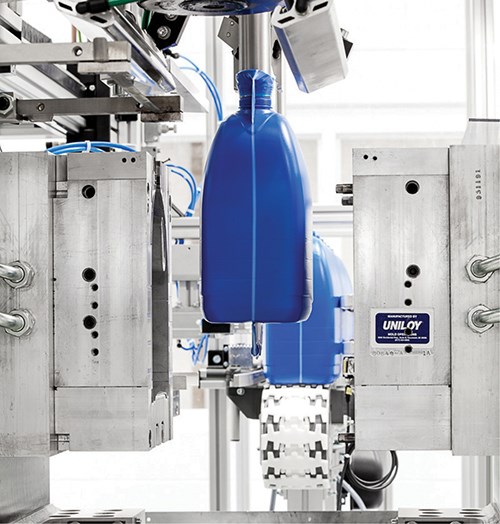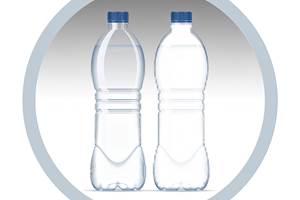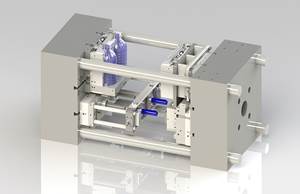Two New Blow Molding Tech Centers
Blow Molding
Uniloy offers a range of new and expanded services for extrusion blow and injection-blow molders.
Two recent announcements from Uniloy, div. of Milacron LLC promise a step up in training, development, and other services for blow molders. In May, Uniloy formally opened its greatly enlarged extrusion blow molding center and announced plans for another to open in the next few months for injection-blow molding.
BLOW MOLDING CENTER OPENS
The first event was the grand opening of Uniloy University at Uniloy North America’s headquarters in Tecumseh, Mich. Its 15,000 ft2 are dedicated to customer training, mold trials, and product and process development for extrusion blow molding.
Uniloy University has been fully up and running since February with three machines (versus just one previously):
• Model 350R2, a 90-ton model in Uniloy’s older, workhorse R series of reciprocating-screw extrusion machines that has been a standard in the dairy industry. It carries one or two heads for containers up to 5 gal/20 liters. It has electric screw drive.
• Model UR70, a 30-tonner in the newer UR series reciprocating-screw units. It’s a twin-head machine for up to 2-gal/8L containers, also with electric screw drive.
• Model UMS12E, 12-metric-ton, all-electric, continuous-extrusion shuttle machine from Uniloy’s B&W operation in Germany. It has a W. Muller head (standard on these models) with six vertical auxiliary extruders (plus the main extruder), providing capability for six-layer coextrusion with barrier, adhesive, and regrind layers, as well as a view stripe. The head allows moving the regrind layer from the inner to the outer portion of the structure with a simple switching of a valve. Its single head runs up to 10L containers. (W. Muller in Germany has a U.S. office in Agawam, Mass.)
Uniloy University also features a greatly expanded analytical lab for measuring container dimensions and wall thickness, as well as testing for drop impact and top-load strength. It has classroom facilities and new operator training courses are being developed for both the new UR Series machine and the 350R systems.
Other capabilities of the tech center are container design prototyping (as in the past) plus production feasibility studies, market-test runs of up to 20,000 bottles, resin trials, and product optimization. A new area of activity, notes Eric Hallstrom, sales manager for new business development, is original R&D, which has focused initially on sustainability initiatives like light- weighting designs and other resin-saving technologies. For example, Uniloy has recently worked with calcium carbonate supplier Omya Inc., Cincinnati, and masterbatch producer Heritage Plastics Inc., Picayune, Miss., to explore cost savings by substituting up to 7% fine-particle CaCO3 for more expensive HDPE resin in dairy jugs.
Tests also show energy savings (kW/lb) of up to 10% or more. Another sustainability project at the tech center involved testing biobased HDPE derived from sugarcane ethanol and supplied by Braskem America Philadelphia. Mike Kippnick, Uniloy global product manager and head of the tech center, says this “Green PE” runs just like standard material, but he envisions using up to 30% of it in dairy containers because of its cost.
North American sales manager Tim Tomlin notes that Uniloy University has the additional advantage of Uniloy’s mold-building operation located in the same building just next door.
NEW PARTNERSHIP FOR INJECTION-BLOW
A second major announcement by Uniloy was its new partnership to develop an injection-blow molding development center with Big 3 Precision Molds. They are establishing this tech center at Big 3 Precision’s Millville, N.J., moldmaking facility for injection-blow molds (which Uniloy itself does not make). For customer training and product/process development, the 1500-ft2 tech center will provide a GMP-certified, climate-controlled lab with two Uniloy injection-blow machines, supported by Uniloy technicians:
• The latest UIB 199-3 hybrid machine (180 tons) for monolayer applications.
• A smaller UIB 54-3 (45 tons) for multi-layer coinjection development.
Uniloy is putting special emphasis on adapting technologies from its Milacron sister companies, Mold-Masters, Kortec, and DME. For one thing, it is adapting Mold-Masters’ Axiom hot-runner technology and TempMaster hot-runner controller to injection-blow. Uniloy is also especially excited by the potential of harnessing Mold-Masters’ and Kortec’s coinjection technologies for barrier packaging in food and medical applications. These include not only special multi-layer injection nozzles but also Mold-Masters’ E-Multi electric-driven auxiliary injection units. Hallstrom calls this collection of technologies potentially “game-changing” for injection-blow.
The monolayer machine will have a 20-cavity test mold for 50/60 cc tablet bottles using Mold-Masters’ Axiom hot runner. For the coinjection system, Uniloy and Big 3 Precision are developing 20-30 cavity systems for barrier applications such as COC/nylon/COC and PC/nylon/PC. The two firms have already done prototype work and short-run production for the first commercial application of coinjection-blow technology.
Through this partnership, Uniloy will be offering turnkey injection-blow systems with single-sourcing of the machine, mold, hot runner, die set, and auxiliary equipment, all fully integrated and tested prior to shipment. Says Hallstrom, “We are employing the total systems approach that has been so successful for Uniloy’s intermittent-extrusion, reciprocating-screw technologies.”
Related Content
Mold Opaque White PET Bottles – Without Pigment
Trexel and Husky are cooperating on molding recyclable opaque white preforms for PET bottles, which provide a light barrier using foam instead of pigment.
Read MoreSolve Four Common Problems in PET Stretch-Blow Molding
Here’s a quick guide to fixing four nettlesome problems in processing PET bottles.
Read MoreKrones Acquires Netstal
Krones adds PET preform injection molding to its bottle blowing and filling capabilities, as well as cap molding and expansion into medical, food and other markets.
Read MoreAt NPE, Cypet to Show Latest Achievements in Large PET Containers
Maker of one-stage ISBM machines will show off new sizes and styles of handled and stackable PET containers, including novel interlocking products.
Read MoreRead Next
How Polymer Melts in Single-Screw Extruders
Understanding how polymer melts in a single-screw extruder could help you optimize your screw design to eliminate defect-causing solid polymer fragments.
Read MoreWhy (and What) You Need to Dry
Other than polyolefins, almost every other polymer exhibits some level of polarity and therefore can absorb a certain amount of moisture from the atmosphere. Here’s a look at some of these materials, and what needs to be done to dry them.
Read MoreProcessor Turns to AI to Help Keep Machines Humming
At captive processor McConkey, a new generation of artificial intelligence models, highlighted by ChatGPT, is helping it wade through the shortage of skilled labor and keep its production lines churning out good parts.
Read More




























